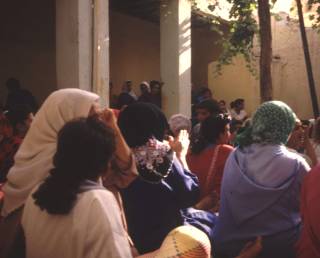Much of my fieldwork was carried out in the large
provincial town of Oujda, in the North-East of Morocco.
It had the reputation, nationally, as a far-flung,
somewhat backward part of the Kingdom, with as many
associations with nearby Algeria as with the state to
which it belonged. Many Oujdis (the inhabitants of
the town) who I came to know considered local society as
rather traditional and conservative in its ways and were
frequently disdainful of the
‘Western-influenced’ materialism and immorality
held to exist in the bigger Moroccan cities of Casablanca
and Tangiers. Despite many strong links with their
Algerian neighbours, Oujda was, at least in its public
manifestations, as patriotic about being Moroccan as
anywhere else in the country. Since the recent political
turmoil erupted across the border in Algeria, many Oujdis
were coming to consider their community as something of a
bastion against both materialism on the one hand and
religious extremism; a stance reinforced by government
rhetoric at the national level.
In the course of my research I
became involved in several distinct musical
communities, including one group of women who met
each week to play and sing religious music for an
all female audience. This group called themselves
the Aissawa and were led by a woman in her
early sixties who referred to herself as the Fqira
(1).
Every Friday afternoon, a time of the week when
devout males worshipped at the mosque, around one
hundred women from all over the town, but
especially from the local, poorer quarters, met
at a small, walled enclosure. |

In the
laneways of Oujda's medina ,
men keep a vigilant eye on their neighbourhood
|

Behind
high walls, but open to the sky,
the space is prepared for the Aissawa gathering
|
This courtyard was open to the
sky with one small doorway opening onto a lane
near the centre of the ancient medina part
of the city. As the audience arranged themselves
and their smaller children on rugs, the Fqira
and another six or seven other female musicians
seated themselves at one end of the courtyard and
began to sing chants and play bnader,
(sing. bendir, a common North African
frame drum) (2).
These chants were repetitive and mostly comprised
of call and response patterns, so that, through
clapping and singing, the audience became
intimately involved in the performance. |
The themes of these songs were largely
concerned with praise of God and beseeching more local
religious personalities for their intercedence in
delivering practical help to the gathered women. What was
asked of these spiritual intermediaries might be for
general assistance or, as in this example, quite
specific.
 Extract from
a common Aissawa chant: 'Allah hu akbar' Extract from
a common Aissawa chant: 'Allah hu akbar'
(wav file: 226 kb)
| |
'Call'
'Response' Sidi Yahya a'tina
baroud
- Allah hu akbar
Sidi Yahya a'tina
baroud
- Allah hu akbar
Hayza
n'zourou
- Hayza n'zourou
Sidi Yahya a'tina
l'visa
- Allah hu akbar
|
| Translation |
|
| |
Sidi Yahya give us the
powder - God
is great
<the force, literally,
"gunpowder" (3)>
x2
Let us visit <his
shrine>
- Let us visit
Sidi Yahaya give us the Visa (4)
- God is Great
|
In this example, although Allah is
acknowledged as the supreme authority, it is a
local maraboutic saint, Sidi Yahya, whose
shrine has been the site of pilgrimage since
pre-Islamic times (see Guitoni, 1993), who is
asked for both power and freedom of movement.
Other saintly figures were also invoked, mostly,
like Sidi Abd el Kader and Sidi Mimoun,
these had shrines nearby, whilst others,
including Lalla Fatimah, the Prophet Mohammed's
daughter, enjoyed more universal devotion.
Each saint was believed to be efficacious in
relieving particular problems, from infertility
and illness to the unemployment or imprisonment
of a family's breadwinner |

Women,
with smaller children,
crowd the Aissawa space each Friday afternoon
|
|


